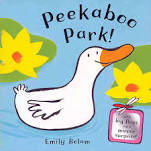Inspiring Young Readers
 posted on 12 Jul 2016
posted on 12 Jul 2016
The Complexity of Simple Picture Books
I recently bought a board book for my new baby grandson - Peekaboo Park by Emily Bolam - and suggested that my son might like to write a review about it. Whilst he really liked the book, he gave a somewhat panicked response to my request saying ' but there are hardly any words or pictures in it so what would I write?'
This reminded me of reading an interesting comment from a picture book academic ( and yes there are lots of them) who suggested that the less there is in a book, the more that there is for children to find. This builds on the idea that all picture books are vital for developing the imagination because reading them is about looking at what is there as well as filling the spaces between the pages. I can just hear my baffled son saying 'but what does that mean for my eleven day old baby?'. Well, even though I am a passionate advocate for giving books to very young children, I accept that my grandson's imagination is still in its very early stages so it's probably not sensible to worry too much about this as yet. It is the physical experience of beginning to perceive the colours and shapes plus the listening experience of hearing the rhythms of the words and of course the close social emotional bond formed by sharing a story that really matters. And as the months go by, he will probably try to eat it as well - which is absolutely fine.
You might say that in that case, surely any book would do the trick? I suppose that might be true but ideally reading should be an enjoyable experience for the baby and adult. There are now hundreds of board books to choose from and I believe that providing all shapes and sizes with range of illustrations is the beginning of helping a child to learn to develop visual discrimination and an awareness of different aesthetic styles.


So then why did I select this one in particular? I liked the bold simplicity of the cover illustration which I thought would attract his attention. I also I know from experience that ' lift the flap' books are very engaging because they directly involve the reader from the outset. The naive representation of the white duck against the blue background was pleasing with the colour orange of its beak repeated in the centre of the three flowers at each side. I also liked the hint that this was a detail of a bigger picture because one flower was only represented by a fragment. For me , this meant that it could be a book about a big river or stream that went outside the confines of the story. In other words, the design of the cover successfully pulled me in.
The shape of the story is very repetitive and predictable, which means that it can be read very easily and quickly. So on the first double size spread we have a different colour palette of pinks and purples to contrast with the black and orange stripes of the stylised bee. As on all the subsequent pages, the text on the left hand side poses the question ' Peekaboo, who are you' and then the reader has the tantalising hint of the creature who is to be revealed along with a bright orange flap with the text 'Buzz buzz' written on it as a clue. There is just one verb used for each creature to add another layer of vocabulary, in this case it is'busy'.


And so we move through the park discovering a duck and then a frog. If you take the time to carefully consider the design of the page, the colours and shapes used and the overall simplicity and power of the pictures and text, this is a picture book that is indeed more complicated and skilful than it may first appear. I'm rather glad that I decided to look at in more detail. The last double page spread reveals a mirror which hopefully reflects the face of the happy baby reader. By this time, with all the exciting interactions that precede, the baby is truly inside this charming picture book.
Karen Argent
14th July 2016